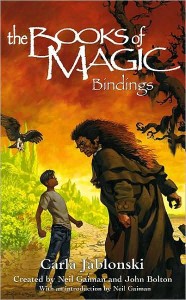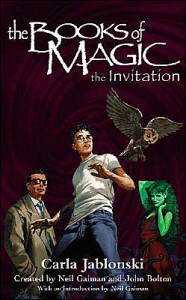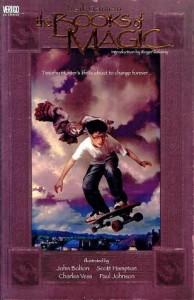

 The Books of Magic, by Neil Gaiman and John Bolton (Vertigo, 1990-1991)
The Books of Magic, by Neil Gaiman and John Bolton (Vertigo, 1990-1991)
The Books of Magic: The Invitation, by Carla Jablonski (Eos, 2003)
The Books of Magic: Bindings, by Carla Jablonski (Eos, 2003)
In 1990, a literary predecessor of Harry Potter came onto the scene, long before anyone had heard of Hogwarts or Voldemort. Originally published as a four-part graphic novel series, adeptly written by Neil Gaiman and illustrated masterfully by John Bolton, The Books of Magic was intended as an exploration of the past, present, and future of the DC Comics universe from a magical perspective.
Thirteen-year-old British schoolboy Timothy Hunter, an awkward, bespectacled young man living alone with his crippled, depressive father, is approached by a quartet of trench-coated strangers, who give him the once-in-a-lifetime chance to learn about magic. And so Tim takes the chance. Guided in turn by the enigmatic Phantom Stranger, the rakish John Constantine (who stars in his own comic, Hellblazer), the introspective Doctor Occult (notably one of the first comic heroes, preceding Superman in appearance) and the fanatical blind Mister E., Tim is taken on a journey of discovery, magic, and danger. From the beginnings of the universe, to the myth of Atlantis, to the cave of Merlin as a young man, to the Burning Times when magic was persecuted, Tim learns how it all came about. John Constantine takes him on a tour of magic in the modern day, introducing him to another DC Comics staple, the beautiful Zatanna. Doctor Occult and his other self, Rose, show Tim the other worlds out there, including the treacherously lovely lands of Faerie. And Mister E. takes Tim into the future, as far as the end of time, where Death herself (a favorite of many Sandman readers) waits. Brilliant and beautiful, the original Books of Magic remains a graphic novel masterpiece, on par with any of Gaiman’s Sandman stories or Stardust.
In 1994, Tim Hunter returned in his own ongoing comic book series, initially written by John Ney Reiber. Chronicling the slow education of Tim, destined to be one of the greatest magicians in the world and to play a major part either for good or evil in the years to come, the Books of Magic series saw him dealing with dangers internal and external, wrestling with the nature of his true identity and parentage, and journeying to worlds as vast and dangerous as Faerie, and America. He found and lost love, freed and destroyed worlds, confronted his evil self, bargained with demons and succubi and angels, and ultimately graduated to the next phase of his education. Though that series ended after six years and seventy-five issues, it did result in several spinoffs, The Books of Faerie, each miniseries looking at the rise and/or fall of Titania, Auberon, and Molly, the first two the erstwhile rulers of Faerie and the last Tim’s on-again, off-again girlfriend, caught up in events beyond her control. Another miniseries, The Names of Magic, written by Dylan Horrocks, saw Tim seeking his true name, so he could enroll in the mysterious, world-spanning White School, sort of a Hogwarts on multi-dimensional acid for the college level. This, in turn, was followed by Hunter: The Age of Magic, a currently ongoing series that follows a more grown-up and mature Timothy Hunter. On one level, and to do both Hunter and Potter a serious injustice, I could easily say that any of the above series are the closest you’ll come to seeing Harry Potter in comic book format. But they’re really quite different, exploring different themes and stories. Which brings me to the true point of this essay.
For whatever reasons, DC has decided that now is the perfect time to release Young Adult novel/adapations of the Books of Magic, starting at the very beginning with the Gaiman series. Adapted into novel format by author Carla Jablonski, the first volume in the series retells the four issues detailing Tim’s initial foray into the worlds of magic, while the second retells the first four issues of the first ongoing series, which has also been reprinted as a trade paperback under the name Books of Magic: Bindings. Both books are already out in stores, and I eagerly sought them out, confident that they’d be faithful and worthy versions of stories I’d read numerous times since they first came out.
I was both right and wrong. Carla Jablonski was indeed faithful to the source material, perhaps to a fault. While the books do go into more detail and introspection on the part of certain key characters, such as Tim Hunter, and they add in a bit more background scenery, they really don’t break out of the original mold. Worse still, while they’re quite descriptive and atmospheric, they don’t come close to capturing the eerie, lifelike resonance and the subtle tones of Bolton’s artwork. If you’ve seen the original comics, the book just don’t hold up. And to my mind, the story feels, well, dumbed down a little for the targeted age group, as if afraid to stick to its guns. Missing are scenes both small and large, leaving gaping holes where the experienced reader and pre-existing fan is concerned, and what worked well in graphic format seems lacking in text format. Successful novelizations of comic books are possible (see Gaiman’s own adaptation of Stardust or Elliot S! Maggin’s exploration of Mark Waid and Alan Ross’s Kingdom Come as prime examples) so it’s hard to imagine why I came off feeling so deflated after reading Jablonski’s first two efforts.
I commend her for her efforts, and I do allow that for younger readers, and for those not already exposed to the original material, these are perfectly acceptable, though they don’t possess the same compelling nature of complexities of many YA books in the same class (such as Harry Potter or the Young Wizards series by Diane Duane). The only real way I can feel good about recommending the novelizations of The Invitation and Bindings is as a stepping-stone towards reading the source material as it was intended. Hopefully, Jablonski or whoever continues to adapt the series, will be given more freedom or confidence to add her own touches to the stories. As a fan, I’ll continue to check out these YA adapations, but I’m seriously afraid that they’ll fail to capture either existing fans, or those looking for a Harry Potteresque fix. Do yourselves a favor and look for the originals, which have been reprinted a number of times in convenient and classy trade paperback editions.
